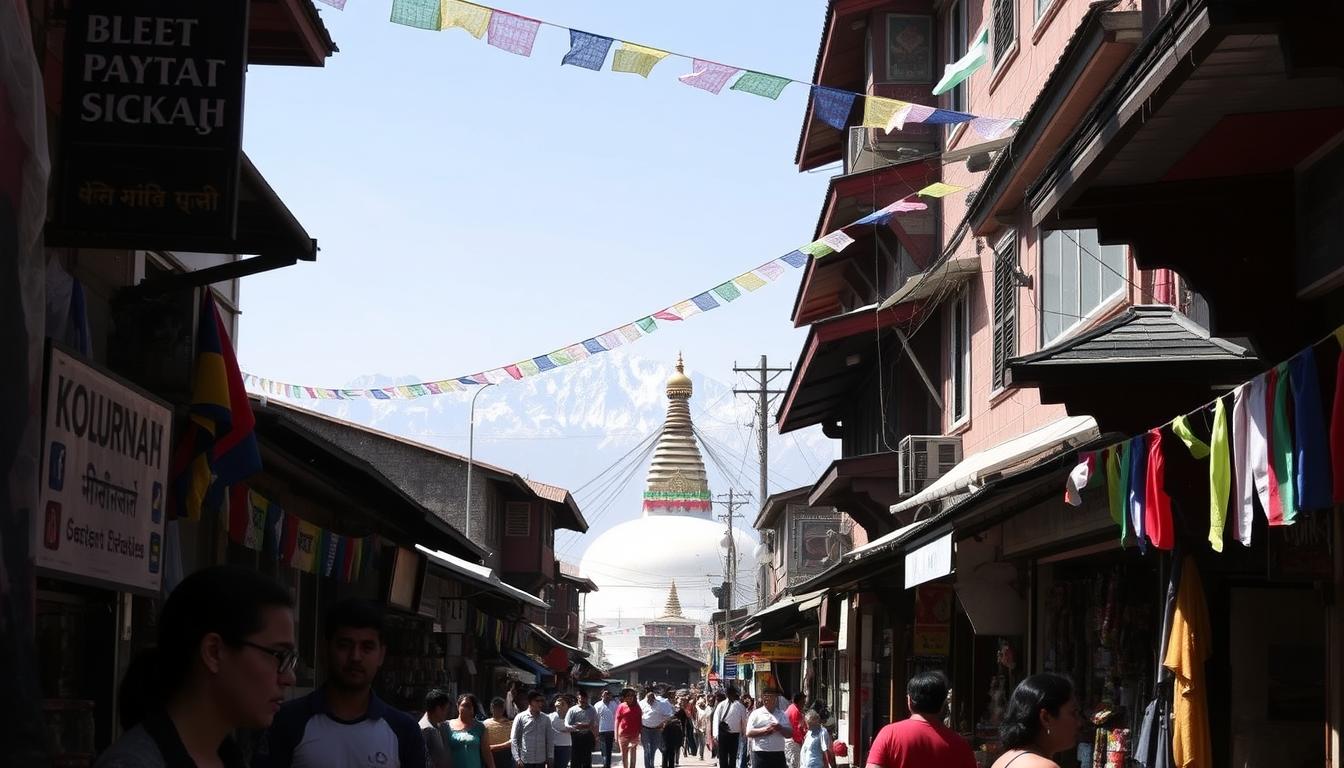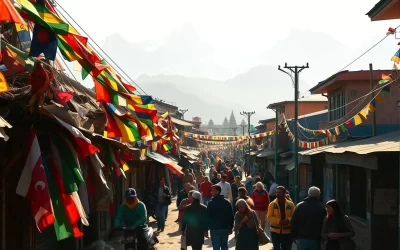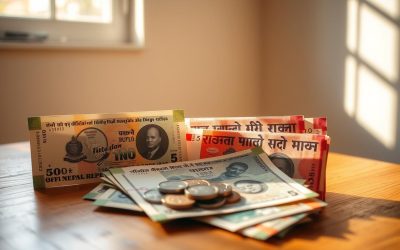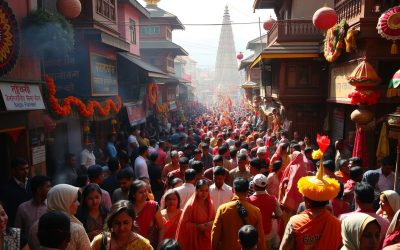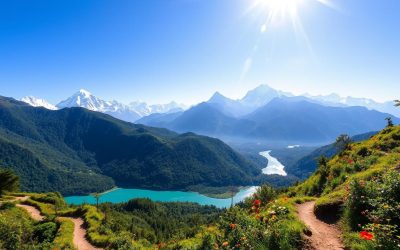Have you ever wondered how timing can make or break your travel experience? When planning a trip to a destination with diverse weather and cultural richness, choosing the right month is crucial. This is especially true for a place where conditions can shift from tropical warmth to sub-zero mountain chill.
Nestled at 4,600 feet, this city offers a unique blend of adventure and tradition. Whether you’re dreaming of high-altitude treks or exploring vibrant festivals, understanding the climate is key. Factors like temperature, season, and daylight hours play a big role in shaping your journey.
With proper planning, you can enjoy optimal conditions year-round. Ready to discover the best time to pack your bags and embark on an unforgettable adventure? Let’s dive in.
Key Takeaways
- Plan your visit based on your preferred activities, such as trekking or cultural exploration.
- Autumn and spring are ideal for outdoor adventures and clear skies.
- Winter offers comfortable conditions for lower-altitude travel.
- Monsoon season is best avoided unless visiting drier regions.
- Daylight hours vary significantly, so plan your days accordingly.
Understanding Nepal’s Diverse Climate
Ever thought about how a country’s geography shapes its weather? In Nepal, the answer lies in its dramatic elevation changes. From the tropical lowlands to the icy peaks of the Himalayas, this country offers a climate for every traveler.
Climate Zones and Seasonal Variations
Nepal’s geography creates four distinct climate zones. The Terai region, near the Indian border, experiences hot, humid weather. In contrast, the hill areas, like Kathmandu and Pokhara, enjoy moderate temperatures year-round. Higher up, the mountain regions are cold and snowy, especially in winter.
Each season brings unique conditions. Spring and autumn are ideal for trekking, with clear skies and comfortable temperatures. Summer brings heavy rains, while winter offers crisp, cool days perfect for lower-altitude adventures.
Regional Weather Patterns
Understanding regional weather is key to planning your trip. The Terai can reach scorching temperatures, while the hills stay pleasantly mild. In the high Himalayas, weather can change rapidly, with snowstorms possible even in spring.
For example, Pokhara receives over 120 inches of rain annually, making it lush and green. Meanwhile, the Mustang region stays dry, with only about 12 inches of rainfall each year. These patterns highlight the importance of choosing the right time and place for your activities.
Whether you’re exploring bustling cities or trekking through serene mountain trails, Nepal’s diverse climate ensures a memorable experience. Plan wisely to make the most of your adventure.
Why Timing Matters for Your Adventure
Timing can transform your adventure from ordinary to extraordinary. Whether you’re planning a challenging trek or exploring cultural gems, the best time to visit ensures comfort and success. Seasonal changes, altitude differences, and temperature fluctuations all play a role in shaping your experience.
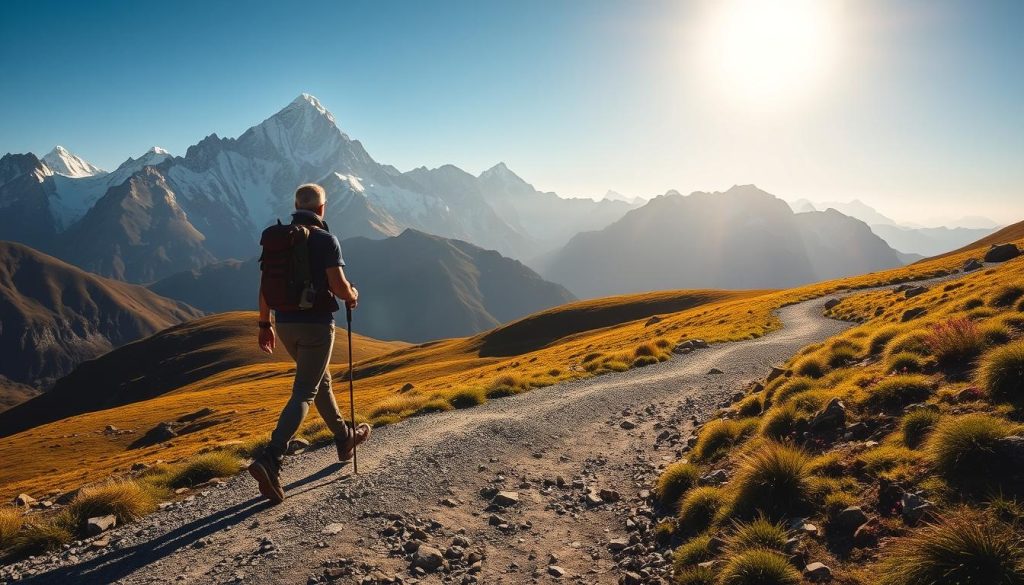
Temperature, Altitude, and Comfort
At higher altitudes, temperature drops significantly, even during warmer months. For example, oxygen levels at 18,500 feet are only around 50% of those at sea level. This can affect your energy and comfort during a trek.
In lower regions, the weather is milder, but humidity can still impact your journey. Choosing the right time ensures you avoid extreme conditions and enjoy your adventure to the fullest.
Influence on Trekking and Activities
Seasonal weather directly affects trekking routes and safety. For instance, the pre-monsoon season (March-May) is colder but offers clear skies, while the post-monsoon season (September-November) is warmer with lush landscapes.
Here’s a quick comparison of the two main trekking seasons:
| Season | Temperature | Conditions |
|---|---|---|
| Pre-Monsoon | Colder | Clear skies, fewer crowds |
| Post-Monsoon | Warmer | Lush greenery, busier trails |
Plan your trek based on your preferences and physical readiness. Proper timing ensures you tackle the right challenges and enjoy every moment of your journey.
Exploring Kathmandu’s Unique Weather Patterns
What makes urban and mountain climates so different? In Kathmandu, the answer lies in its elevation and proximity to the Himalaya. The city’s moderate climate contrasts sharply with the extreme conditions found higher up. Understanding these differences can help you plan your trip better.
City Versus Mountain Conditions
In the city, temperatures are relatively stable, with warm days and cooler nights. This is due to its elevation of around 5,000 feet. Higher in the mountains, however, the weather can change rapidly. Snowstorms are possible even in spring, and temperatures drop significantly at night.
The monsoon season also affects both areas differently. In Kathmandu, heavy rains can flood streets, while mountain trails become slippery and dangerous. Yet, the rain brings lush greenery to the hills, creating stunning landscapes.
“The contrast between city and mountain climates is striking. It’s like stepping into two different worlds in one trip.”
Altitude plays a big role in these variations. The higher you go, the thinner the air becomes, affecting both your comfort and energy levels. In the city, the air is denser, making it easier to breathe and explore.
Here’s how you can prepare for these conditions:
- Pack layers for fluctuating temperatures.
- Bring waterproof gear for the monsoon season.
- Acclimate gradually if trekking in the mountains.
By understanding these patterns, you can enjoy both the urban charm and the rugged beauty of the Himalaya. Plan wisely to make the most of your adventure.
Kathmandu, Nepal: Best Months for a Weather-Savvy Trip
Planning your trip around the right season can make all the difference. Whether you’re exploring ancient temples or trekking through lush landscapes, timing is everything. The best time to visit depends on your preferred activities and the weather conditions you’re comfortable with.
Ideal Conditions for Outdoor Activities
Spring (March to May) and autumn (September to November) are the most popular times to visit. These months offer mild temperatures and clear skies, perfect for outdoor adventures. In spring, the hills come alive with blooming rhododendrons, while autumn brings golden landscapes and vibrant festivals.
During these seasons, you can enjoy activities like hiking, sightseeing, and cultural exploration without worrying about extreme weather. The temperature ranges from 60°F to 85°F, making it comfortable for long days outdoors.
Overview of Peak and Off-Peak Seasons
Peak seasons coincide with spring and autumn, attracting more travelers. While this means busier trails and higher accommodation costs, it also ensures a lively atmosphere and better accessibility to services. Off-peak seasons, like summer (monsoon) and winter, offer fewer crowds and lower prices but come with their own challenges.
Here’s a quick comparison of the seasons:
| Season | Pros | Cons |
|---|---|---|
| Spring | Mild weather, blooming flowers | Busier trails, higher costs |
| Autumn | Clear skies, vibrant festivals | Peak tourist season |
| Summer | Lush greenery, fewer crowds | Heavy rains, slippery trails |
| Winter | Lower prices, clear views | Colder temperatures, limited trekking |
Popular festivals like Dashain and Holi often align with the best weather, adding cultural richness to your trip. By understanding these seasonal nuances, you can plan a memorable adventure tailored to your preferences.
Planning Your Trekking and Mountain Excursions
What does it take to plan a successful mountain excursion? Whether you’re aiming for the Annapurna Circuit or Everest Base Camp, preparation is key. High-altitude treks demand careful planning, from gear selection to route considerations. Let’s break down the essentials to ensure your adventure is both safe and unforgettable.
Preparing for High Altitude Treks
High-altitude trekking requires more than just physical fitness. Proper gear is essential to handle the varying conditions you’ll face. Start with a sturdy pair of boots, thermal layers, and a reliable sleeping bag. Many trekkers rent gear locally, which can save space and money.
Acclimatization is another critical factor. Moving too quickly to higher altitudes can lead to altitude sickness. Plan rest days to allow your body to adjust. Hydration and a balanced diet also play a big role in keeping your energy levels up.
Here’s a quick checklist for your preparation:
- Invest in quality trekking gear, including waterproof layers.
- Carry a first-aid kit and altitude sickness medication.
- Plan your route with acclimatization days included.
- Stay hydrated and eat nutrient-rich meals.
Route and Trail Considerations
Choosing the right trail is just as important as preparing your gear. Popular routes like the Annapurna Circuit and Everest Base Camp offer well-marked paths and teahouse accommodations. These are great for beginners or those seeking a structured experience.
For a more secluded adventure, consider lesser-known trails. These routes often provide stunning views without the crowds. However, they may require more self-sufficiency and navigation skills.
Here’s a comparison of popular and lesser-known trails:
| Trail | Difficulty | Highlights |
|---|---|---|
| Annapurna Circuit | Moderate | Diverse landscapes, teahouse stays |
| Everest Base Camp | Challenging | Iconic views, Sherpa culture |
| Manaslu Circuit | Advanced | Remote beauty, fewer trekkers |
Regardless of your choice, always check weather conditions and trail updates before setting out. Proper planning ensures you’re ready for the challenges and rewards of high-altitude trekking.
Maximizing Your Trip During the Spring Season
Spring brings a burst of color and energy to the region, making it a favorite for travelers. The season of renewal offers a perfect blend of natural beauty and cultural vibrancy. From blooming flowers to lively festivals, this time of year is ideal for exploration.
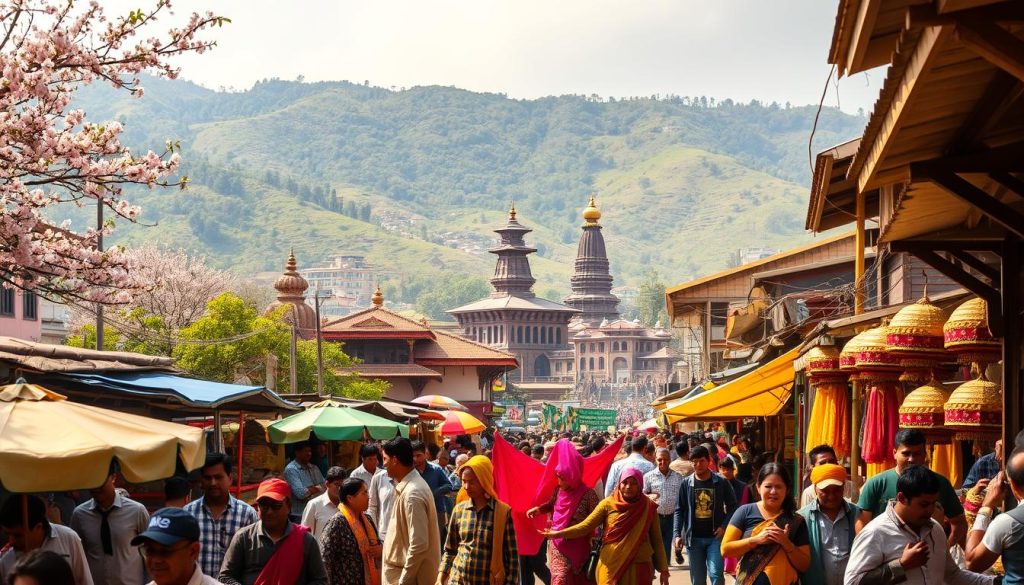
Blooming Landscapes and Festivals
Spring transforms the region into a canvas of vibrant colors. Rhododendrons bloom across the hills, creating stunning landscapes. Clear skies and mild temperatures make it a good time for outdoor activities like trekking and sightseeing.
Cultural festivals add to the charm of the season. Holi, the festival of colors, fills the streets with joy and celebration. The Nepali New Year, celebrated in April, brings traditional music, dance, and feasts. These events offer a unique glimpse into local traditions.
Pleasant Weather for Exploration
From March to May, daytime temperatures range from 60°F to 85°F, creating comfortable conditions for travel. Whether you’re hiking through lush trails or exploring ancient temples, the weather is on your side.
Here’s a quick overview of what to expect during spring:
| Month | Temperature | Highlights |
|---|---|---|
| March | 60°F – 75°F | Blooming flowers, fewer crowds |
| April | 65°F – 80°F | Holi festival, clear skies |
| May | 70°F – 85°F | Lush greenery, warm days |
To make the most of your trip, pack light layers for fluctuating temperatures. Don’t forget sunscreen and a reusable water bottle for long days outdoors. Spring is a time to embrace both nature and culture, so plan your activities accordingly.
Autumn: The Optimal Period for Clear Skies
Ever considered how a single season can elevate your travel experience? Autumn, spanning September to November, is widely regarded as the best time to explore. With clear skies, vibrant colors, and comfortable temperatures, this peak travel period offers unparalleled opportunities for sightseeing and adventure.
Perfect Weather for Sightseeing
Autumn’s weather is a dream come true for travelers. Crisp mornings give way to pleasantly warm afternoons, making it ideal for outdoor activities. The skies are crystal clear, offering breathtaking views of the mountain ranges. Whether you’re trekking or exploring cultural sites, the conditions are perfect.
This season also brings a unique charm to the landscape. Golden hues blanket the hills, and the air feels fresh and invigorating. It’s no wonder that autumn is a favorite among both casual tourists and serious adventurers.
Here’s a quick look at what makes autumn special:
- Clear skies for uninterrupted views of the mountains.
- Cooler temperatures that are comfortable for long days outdoors.
- Vivid colors and lush greenery after the monsoon rains.
Festivals and Activities
Autumn is also a culturally rich time to visit. Festivals like Dashain and Tihar bring communities together, offering a glimpse into local traditions. These events are filled with music, dance, and delicious food, adding an extra layer of excitement to your trip.
For trekkers, the trails are in prime condition. The dry weather ensures safe and enjoyable routes, while the clear skies provide stunning views. Popular destinations like the Annapurna Circuit and Everest Base Camp are particularly rewarding during this month.
| Activity | Benefits |
|---|---|
| Trekking | Clear trails, stunning views |
| Sightseeing | Vibrant landscapes, cultural festivals |
| Photography | Golden light, dramatic backdrops |
While autumn is a peak travel period, it’s worth planning ahead. Accommodations can fill up quickly, and prices may be higher. However, the experience is well worth the effort. From the crisp air to the golden landscapes, autumn offers a truly magical adventure.
Navigating the Monsoon and Off-Season Benefits
Traveling during the monsoon might seem challenging, but it has its own unique rewards. While heavy rains and slippery roads can be a thing to consider, this season also brings lush landscapes and thrilling activities. With the right planning, you can turn the monsoon into a good opportunity for adventure.
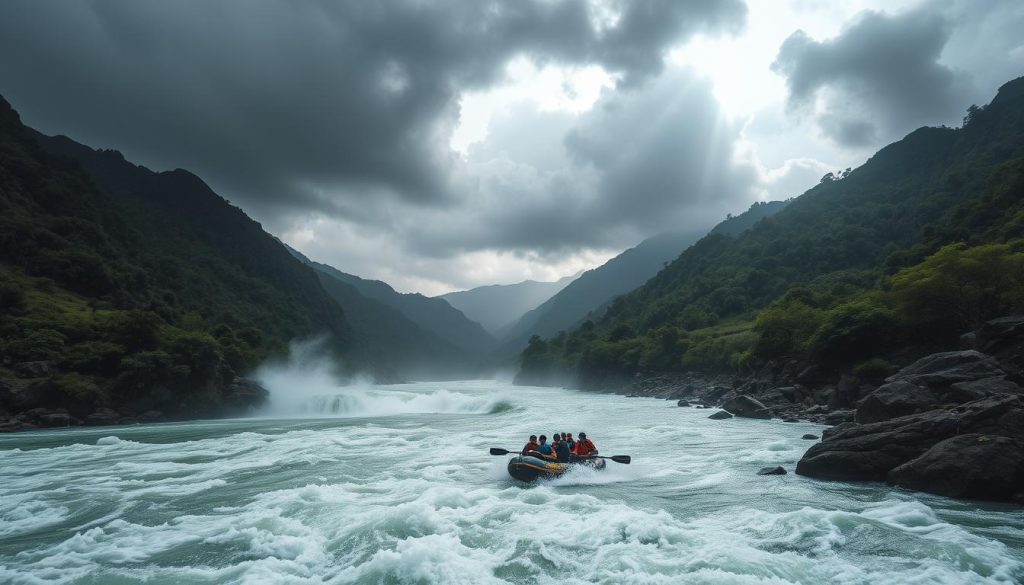
Opportunities for White Water Rafting
The monsoon transforms rivers into powerful currents, making it the perfect time for white water rafting. This adrenaline-pumping activity is a highlight of the season, offering an unforgettable experience. The increased water levels create ideal conditions for rafting, especially in areas like the Trishuli River.
Here’s why rafting during the monsoon is a good idea:
- Stronger currents for a more thrilling ride.
- Fewer crowds, giving you more space to enjoy the adventure.
- Lush, green surroundings that enhance the scenic beauty.
Managing Rainfall and Road Conditions
Rainfall during the monsoon can affect road conditions, but with careful planning, you can navigate these challenges. Roads in some areas may become slippery or flooded, so it’s essential to monitor weather updates and avoid risky zones. Pack waterproof gear and sturdy footwear to stay comfortable.
Here are some tips for safe travel during this season:
- Check weather forecasts regularly to plan your routes.
- Travel with a reliable guide who knows the area well.
- Carry essentials like raincoats, umbrellas, and extra dry clothes.
Off-season travel also has its perks. Fewer crowds mean you can enjoy popular spots without the hustle and bustle. Accommodation and transportation costs are often lower, making it a budget-friendly time to explore. By understanding the monsoon’s unique conditions, you can plan activities that work with, rather than against, the weather.
Tips for Budget-Friendly Travel in Nepal
Looking to explore without breaking the bank? Nepal offers plenty of opportunities for budget-conscious travelers. By planning strategically, you can enjoy the country’s stunning landscapes and rich culture while keeping costs low. Here’s how to make the most of your trip without overspending.
Seasonal Discounts on Hotels and Transit
Traveling during off-peak seasons can save you a lot. The monsoon period (June to September) and winter (December to February) often bring significant discounts on accommodations and transportation. Hotels in popular areas like Pokhara and the Annapurna region may offer rates as low as $5 per night.
Public buses are another affordable option, with fares starting at just $0.15 for short distances. For longer journeys, tourist buses provide a cost-effective alternative to private taxis. Planning your trip during these quieter times not only saves money but also allows for a more personalized experience.
Finding Budget-Friendly Accommodations
Affordable lodging is easy to find, especially in mountain regions and along popular trails. Many guesthouses and teahouses cater to budget travelers, offering basic amenities at low prices. Booking in advance can secure better deals, especially during peak trekking seasons.
Here are some tips for finding budget-friendly stays:
- Look for guesthouses in less touristy areas.
- Negotiate rates directly with owners for better prices.
- Consider shared accommodations to split costs.
Maximizing Your Experience on a Budget
Exploring Nepal doesn’t have to be expensive. Many attractions, like temples and markets, are free to visit. Shorter treks and hikes are a great way to experience the mountains without the high costs of long expeditions. Bargaining is common in local markets, so don’t hesitate to negotiate for better prices.
Here’s a quick comparison of budget-friendly activities:
| Activity | Cost |
|---|---|
| Local bus travel | $0.15 per 5 km |
| Budget guesthouse | $5-$8 per night |
| Short trek | $10-$20 per day |
By traveling smart and taking advantage of seasonal discounts, you can enjoy Nepal’s beauty without stretching your budget. Plan ahead, stay flexible, and embrace the adventure!
Cultural Highlights and Must-Attend Festivals
Have you ever experienced the magic of a festival that brings an entire city to life? In Nepal, celebrations are more than just events—they’re a window into the heart of its culture. From vibrant colors to ancient traditions, these gatherings offer a unique way to connect with the local way of life.
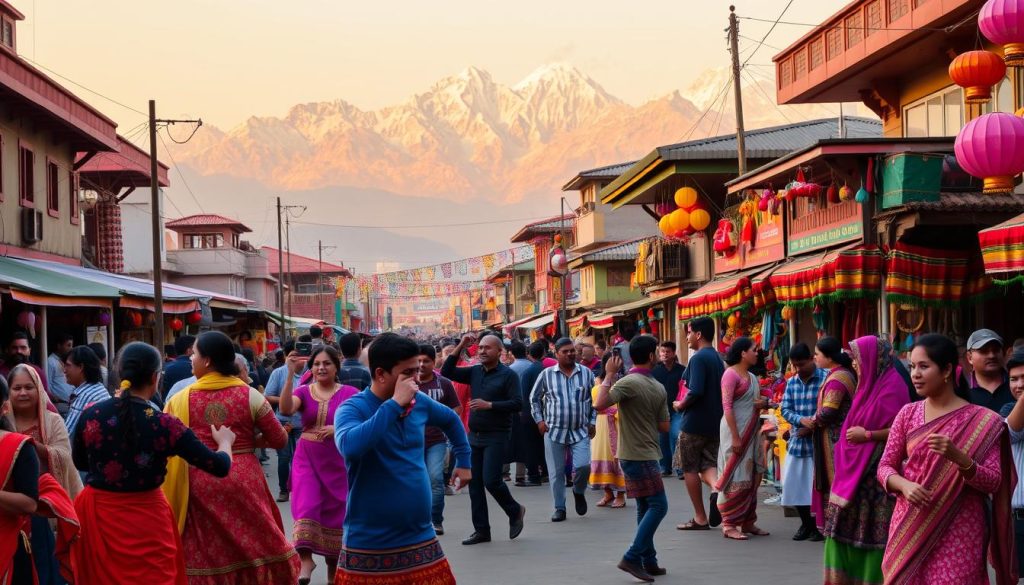
Local Celebrations and Traditions
Nepal’s festivals are deeply rooted in its history and spirituality. Holi, the festival of colors, is a joyous celebration where streets come alive with music, dance, and vibrant powders. Dashain, the longest and most significant festival, honors the victory of good over evil with family gatherings and feasts.
These events are not just for locals—they’re an invitation for tourists to immerse themselves in the culture. Whether you’re trekking through the hills or exploring the bustling streets of Kathmandu, you’ll find that festivals add a layer of richness to your journey.
Key Events in Kathmandu and Beyond
In Kathmandu, the Indra Jatra festival marks the end of the monsoon season with chariot processions and masked dances. Beyond the city, the Mani Rimdu festival in the Everest region is a spiritual event that combines rituals, music, and dance. These gatherings are a testament to the diversity of Nepal’s cultural heritage.
Participating in these events can enhance your trekking experience. Imagine resting in a mountain village after a long day on the trail, only to stumble upon a lively celebration. It’s moments like these that make your adventure truly unforgettable.
Here’s a quick guide to some of the most popular festivals:
| Festival | Date | Highlights |
|---|---|---|
| Holi | March | Colorful celebrations, music, and dance |
| Dashain | September/October | Family gatherings, feasts, and rituals |
| Indra Jatra | September | Chariot processions, masked dances |
| Mani Rimdu | October/November | Spiritual rituals, music, and dance |
These events offer a glimpse into the soul of Nepal. Whether you’re a seasoned trekker or a first-time visitor, participating in a festival will leave you with memories to cherish for a lifetime.
Essential Preparations for a Weather-Savvy Trip
Are you ready to tackle the challenges of unpredictable weather on your next adventure? Proper preparation is the key to ensuring a smooth and enjoyable journey. From packing the right gear to understanding health and safety measures, these steps will help you stay comfortable and safe, no matter the conditions.
Packing and Gear Recommendations
Packing for a trip with varying temperatures and conditions requires careful planning. Layered clothing is essential, as it allows you to adjust to changing weather throughout the day. Start with moisture-wicking base layers, add insulating mid-layers, and finish with a waterproof outer shell.
Footwear is another critical consideration. Sturdy, waterproof boots are a must for trekking, especially in muddy or snowy conditions. Don’t forget accessories like gloves, hats, and sunglasses to protect against the elements.
Here’s a quick checklist for your gear:
- Moisture-wicking base layers and thermal mid-layers.
- Waterproof jacket and pants for rain or snow.
- Sturdy, broken-in hiking boots.
- Sun protection: hat, sunglasses, and sunscreen.
- Reusable water bottle and hydration system.
Health and Safety Considerations
Health and safety should be top priorities, especially when traveling to high-altitude areas like base camps. Altitude sickness is a common concern, so acclimatization is crucial. Take rest days, stay hydrated, and avoid rapid ascents to reduce the risk.
Carry a basic first-aid kit with essentials like bandages, pain relievers, and altitude sickness medication. It’s also a good idea to have a map, compass, or GPS device, especially if you’re venturing into remote areas.
“Preparation is the key to a successful adventure. Pack smart, stay safe, and enjoy every moment of your journey.”
Weather can change quickly, so always check forecasts before heading out. Be prepared for unexpected shifts in temperature or sudden rain, especially during the seasonal transitions in March, April, and May.
By taking these steps, you’ll be ready to handle whatever the weather throws your way. Plan ahead, pack wisely, and focus on enjoying your adventure to the fullest.
Conclusion
Planning your adventure with the right time ensures a seamless and unforgettable experience. Whether you’re trekking through the Himalaya or exploring vibrant festivals, understanding the weather and seasonal changes is key. From crisp winter mornings to lush summer trails, every detail counts.
Use the tips shared here to tailor your trip to your preferences. Pack smart, stay flexible, and embrace the diverse conditions. Whether it’s a challenging trek or a cultural journey, proper preparation makes all the difference.
Start planning today and get ready for an adventure that combines natural beauty, rich traditions, and unforgettable memories. Your next great experience is just a trail away!
The above is subject to change.
Check back often to TRAVEL.COM for the latest travel tips and deals.
Here are some Tours & Sightseeing suggestions that might pique your interests!
